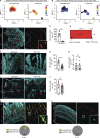Landscape of mast cell populations across organs in mice and humans
- PMID: 37462672
- PMCID: PMC10354537
- DOI: 10.1084/jem.20230570
Landscape of mast cell populations across organs in mice and humans
Erratum in
-
Correction: Landscape of mast cell populations across organs in mice and humans.J Exp Med. 2024 Feb 5;221(2):e2023057001172024c. doi: 10.1084/jem.2023057001172024c. Epub 2024 Jan 24. J Exp Med. 2024. PMID: 38265438 Free PMC article. No abstract available.
Abstract
Mast cells (MCs) are tissue-resident immune cells that exhibit homeostatic and neuron-associated functions. Here, we combined whole-tissue imaging and single-cell RNA sequencing datasets to generate a pan-organ analysis of MCs in mice and humans at steady state. In mice, we identify two mutually exclusive MC populations, MrgprB2+ connective tissue-type MCs and MrgprB2neg mucosal-type MCs, with specific transcriptomic core signatures. While MrgprB2+ MCs develop in utero independently of the bone marrow, MrgprB2neg MCs develop after birth and are renewed by bone marrow progenitors. In humans, we unbiasedly identify seven MC subsets (MC1-7) distributed across 12 organs with different transcriptomic core signatures. MC1 are preferentially enriched in the bladder, MC2 in the lungs, and MC4, MC6, and MC7 in the skin. Conversely, MC3 and MC5 are shared by most organs but not skin. This comprehensive analysis offers valuable insights into the natural diversity of MC subtypes in both mice and humans.
© 2023 Tauber et al.
Conflict of interest statement
Disclosures: X. Dong reported personal fees from Escient Pharmaceuticals and GlaxoSmithKline outside the submitted work. S.J. Galli reported grants from National Institutes of Health, personal fees from Evommune, Inc., and personal fees from Jasper Therapeutics, Inc. outside the submitted work. No other disclosures were reported.
Figures












References
Publication types
MeSH terms
Associated data
Grants and funding
LinkOut - more resources
Full Text Sources
Molecular Biology Databases

